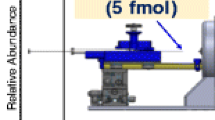Abstract
Mouse urine contains substantial quantities of a family of proteins (MUPs) that are members of the lipocalycin family of proteins and that are potentially capable of binding hydrophobic molecules. We have used gas chromatography-mass spectrometry (GC-MS) to characterize two ligands associated with the MUPs, a thiazole and a brevicomin derivative. Previous work has suggested a role for these two ligands as androgen-dependent pheromones. In urine, nearly all of these ligands are protein bound and fractionation of MUPs on Mono-Q anion exchange chromatography indicated some specificity of ligand binding by the MUP subclasses.
Similar content being viewed by others
References
Adams, P., andSawyer, L. 1990. Structure of rodent urinary proteins.Biochem. Soc. Transac. 18:936–937.
Bacchini, A., Gaetani, E., andCavaggioni, A. 1992. Pheromone binding proteins of the house mouseMus musculus.Experentia 48:419–421.
Bocskei, Z., Findlay, J.B.C., North, A.C.T., Phillips, S.E.V., Somers, W.S., Wright, C.E., Lionetti, C., Tirindelli, R., andCavaggioni, A. 1991. Crystallization of and preliminary X-ray data for the mouse major urinary protein and rat a-2u globulin.J. Mol. Biol. 218:699–701.
Bocskei, Z., Groom, C.R., Flower, D.R., Wright, C.E., Phillips, S.E.V., Cavagioni, A., Findlay, J.B.C., andNorth, A.C.T. 1992. Pheromone binding to two rodent urinary proteins revealed by X-ray crystallography.Nature 360:186–188.
Cavaggioni, A., Sorbi, R.T., Keen, J.N., Pappin, D.J.C., andFindlay, J.B.C. 1987. Sequence homology between pyrazine binding protein, major urinary protein andα-microglobulins.FEBS. Lett. 212(2):225–228.
Cavaggioni, A., Findlay, J.B.C., andTrindelli, R. 1990. Ligand binding characteristics of homologous rat and mouse urinary proteins and pyrazine binding protein of the calf.Comp. Biochem. Physiol. 96B(3):513–520.
Clissold, P.M., andBishop, J.O. 1982. Variation in mouse major urinary protein genes and gene products within inbred lines.Gene 18:211–220.
Clissold, P.M., Hainey, S., andBishop, J.O. 1984. Messenger RNAs coding for MUPs are differentially induced by testosterone.Biochem. Genet. 22(3/4):379–387.
Duncan, R., Matthai, R., Huppi, K., Roderick, T., andPotter, M. 1988. Genes that modify expression of major urinary proteins in mice.Mol. Cell. Biol. 8(7):2705–2712.
Flannery, A.V., Dalzell, G.N., andBeynon, R.J. 1991. Proteolytic activity in mouse urine: Relationship to the kidney metallo-endopeptidase, meprin.Biochim. Biophys. Acta. 1041:64–70.
Finlayson, J.S., Potter, M., andRunner, R.C. 1963. Electrophoretic variation and sex dimorphism of the major urinary protein complex in inbred mice: A new genetic marker.J. Natl. Cancer Inst. 31:91–107.
Jemilo, B., Alberts, J., Sochinski-Wiggins, S., Harvey, S., andNovotny, M. 1985. Behavioral and endocrine responses of female mice to synthetic analogs of volatile compounds in male urine.Anim. Behav. 33:1114–1118.
Laemmli, U.K. 1970. Cleavage of structural proteins during the assembly of the head of bacteriophage T4.Nature 227:680.
Larsen, G.L., Bakke, J.E., andHuwe, J.K. 1990a. Methylsulphone metabolites of m-dichlorobenzene as ligands for α2u-globulin in rat kidney and urine.Xenobiotica 20(1):7–17.
Larsen, G.L., Bergman, A., andKlasson-Wehler, E. 1990b. A methylsulphonyl metabolite of a polychlorinated biphenyl can serve as a ligand for α2u-globulin in rat and major urinary protein in mice.Xenobiotica 20(12):1343–1352.
North, A.C.T. 1991. Structural homology in ligand specific transport proteins.Biochem. Soc. Symp. 57:35–48.
Novotny, M., Lee, M.L., andBartle, K.D. 1974. Some analytical aspects of the Chromatographic headspace concentration method using a porous polymer.Chromatographia 7(7):333–338.
Novotny, M., Harvey, S., Jemilo, B., andAlberts, J. 1985. Synthetic pheromones that promote inter-male aggression in mice.Proc. Natl. Acad. Sci. U.S.A. 82:2059–2061.
Schellinek, H.M., West, A.M., andBrown, R.E. 1992. Rats can discriminate between the urine odours of genetically identical mice maintained on different diets.Physiol. Behav. 51:1079–1082.
Schwende, F.J., Weisler, D., Jorgenson, J.W., Carmac, M., andNovotny, M. 1986. Urinary volatile constituents of the house mouseMus musculus and their endocrine dependency.J. Chem. Ecol. 12(1):277–296.
Vandenbergh, J.G., Whitsett, J.M., andLombardi, J.R. 1975. Partial isolation of a pheromone accelerating puberty in female mice.J. Reprod. Fertil. 43:515–523.
Yamazaki, K., Yamaguchi, M., Boyse, E.A., andThomas, L. 1979. The MHC as a source of odours imparting individuality among mice, pp. 267–273,in Chemical Signals: Vertebrates and Aquatic Invertebrates. D. Muller-Schwarze and R.M. Silverstein (eds.). Plenum, New York.
Author information
Authors and Affiliations
Rights and permissions
About this article
Cite this article
Robertson, D.H.L., Beynon, R.J. & Evershed, R.P. Extraction, characterization, and binding analysis of two pheromonally active ligands associated with major urinary protein of house mouse (Mus musculus). J Chem Ecol 19, 1405–1416 (1993). https://doi.org/10.1007/BF00984885
Received:
Accepted:
Issue Date:
DOI: https://doi.org/10.1007/BF00984885




